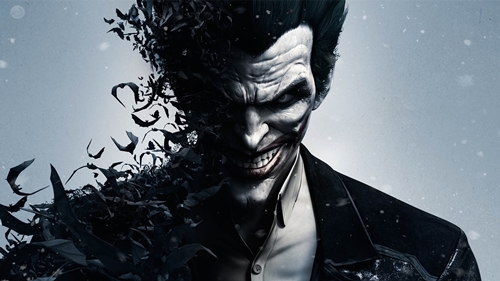
“When it comes to the Joker, I think there’s a lot more self-doubt than there is with other characters. He really is his arch-nemesis. He is the devil in his ear. He tells you all the things you’re most afraid of are true about you.” Scott Snyder on the Joker as Batman’s nemesis
The Joker is a character that writers love to play with, a character open to various interpretations each rich in their own subtext.
As an archetype the Joker is a Trickster – he disobeys societies rules and conventional behavior. He is a shapeshifter, a clown, he is the best class of criminal that Gotham has ever seen.
Where Batman is about control, precision and discipline and serving a higher good, the Joker is about unrestrained spontaneity and wild glorious mayhem in a whirlwind of chaos. He serves only himself. If he has a higher calling it is to cause as much harm and destruction to the people of Gotham while fucking with Batman’s mind any way he can.

Joker as Trickster
The classical Trickster archetype performs a range of functions.
In its most benign form the Trickster is a playful mischievous character (sometimes a shapeshifter) who brings attention to whatever is repressed in our individual or collective psyche. A Trickster is often an inversion of social norms.
The Trickster then is not only a character in a story, but an outer analogue for our own inner psyche. Whatever we are afraid of, whatever we keep repressed or don’t want to face, whatever is unpopular of should not be spoken of in polite society – the Trickster is going to bring attention to all of these things in its own unique way.
With the Trickster (and all archetypes) we are able to take an interior event of our psyche (1st person) and project it on to a character or archetype (3rd person) via story, film etc – in a way that personifies the qualities of that archetype. All archetypes (according to Carl Jung) live in our Unconscious mind, both individually and collectively.
This 3rd person mental abstraction (or character, exterior) then allows us a chance to work with the archetype and reintegrate our own often unconscious or disowned qualities back into our psyche (back to 1st person interior).

While classical Jungian psychology allows for and encourages a healthy relationship with archetypes, to the modern world we are most familiar with archetypes through stories – movies, novels, comics, animation, art etc. The Trickster often is an inversion of our values, of whatever we outwardly say is important. But if the Trickster were merely the opposite of who and what we are, then there would be no truth in the Archetype.
So while the Trickster may appear bizarre, abhorrent, or at least unwelcome, it is merely a reflection of a part of our psyche that we refuse to look at, to integrate or become familiar with. The Trickster then is ultimately a servant of the mind, it exists to allow us a change to come to terms with the ideas we struggle with in a playful way. The Trickster is also a representative of primal forces likes sex, death, procreation and animal instincts.
Archetypes exist in all of our world stories, myths, and legends. They reoccur whether we want them to or not for all stories are reflected aspects of ourselves, and the purpose of stories is not just to entertain but pass on symbolic life lessons and help us transition into different eras of our lives.
Stories and symbols (such as Archetypes) can contain coded information that interacts with out mind at different stages of our lives, the same story can have very different meanings as we grow and evolve. Stories then are also a kind of technology for passing on information critical to human growth. Art is not only essential to human growth and development, but has always been and will always be part of what we are at a fundamental level.
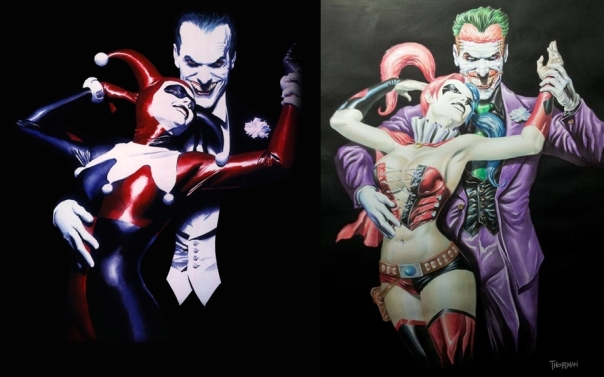
The Joker reoccurs throughout Batman mythology and follows Batman around like a bad smell. You just can’t get rid of him. For Batman to kill the Joker is to become that which he hates – those who would enforce the philosophy of death/execution on any they disagree with. For all of Batman’s psychological hang ups, he believes in the right of all people to live, he will even risk his own life to save those who would do him harm.
This could be viewed as a virtue, or as further evidence of Batman’s nuttiness – why the heck would you go out of your way to help someone who is trying to kill you? It’s one thing to say pull out an unconscious criminal from the wreckage of a prison bus hanging on the edge of a cliff. It’s another thing entirely to try and save someone from falling off a building who is awake and firing bullets at you while you do it.
The trickster is an alchemist, a magician, creating realities in the duality of time and illusion. In mythology, and in the study of folklore and religion, a trickster is a god, goddess, spirit, man, woman, or anthropomorphic animal who plays tricks or otherwise disobeys normal rules and conventional behavior -www.crystalinks.com/trickster.html
Joker as Shapeshifter
The Trickster archetype can also be a shapeshifter, taking on the form of the opposite sex or an animal – which goes some way to explaining the different versions of the Joker across different media, and his personality varies according to whoever the current popular writer may be. The Joker’s ad hoc multiple origins and rebooted continuity (depending on what era of Batman comics you are reading) also fits with the Trickster archetype. Trying to understand the Joker or pin him down is futile.
Heath Ledger’s Joker famously made up multiple origin stories that he would tell to people just to keep them guessing. One ongoing theme in the comics is Batman trying and failing to understand the Joker. Joker’s personality and methods shift with his various incarnations. A shapeshifter is ultimately whatever it wants to be, but also sometimes reflects a twisted version of the values of the hero or protagonist.
Trying to figure out what makes the Joker tick is like asking what is the essential nature of water. Is it liquid, steam or ice? The answer of course is that water is all three of these states, and it will shift between them depending on the conditions of its environment. The Joker can change persona’s and origin stories as easily as changing clothes.
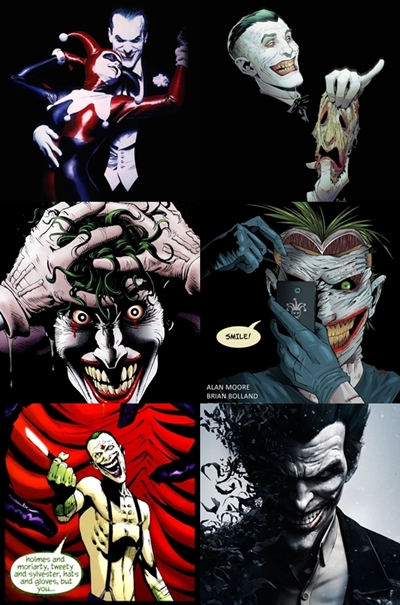
The Joker’s Many Incarnations
Bill Finger gave us the first version of the Joker, a career criminal and killer with a clown motif. Later as the Joker’s background was expanded it was established that he had been a regular criminal who fell into a vat of acid. Instead of dying a painful death – his skin and hair were chemically bleached, his mouth was damaged giving him a permanent grin. He dressed in a purple suit and went with the whole “clown prince of crime” theme. But these elements were not added until years later, so in his earliest appearances, you would assume the Joker’s face to be make-up.
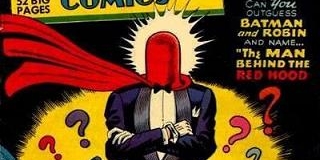
Further adding to the Joker’s origins was the Red Hood persona, a simple red helmet and cape that created a new mystery man in Gotham whom Batman and Robin would have to catch. While the Joker has had a number of redacted origins over the years, Bill Finger and Jerry Robinson deliberately kept the Joker’s origin ambiguous and unknown. It was only later writers who made attempts at adding a true origin to the character, or more accurately an origin of who the Joker was before he was the Joker.
The Red Hood as a gimmick is a common one in superhero genre material. Create a “mystery” character, and tease out who they really are for as long as you can, keeping the readers on the edge of their seats. The strength of this trope is that the character can be anyone, and when revealed, often the character is not whom you suspected – because the writers usually don’t know who it is either. So they throw out multiple clues for different people the mystery person could be. Then they may change the identity at the 11th hour, leaving readers puzzled and often quite angry with all the false clues.
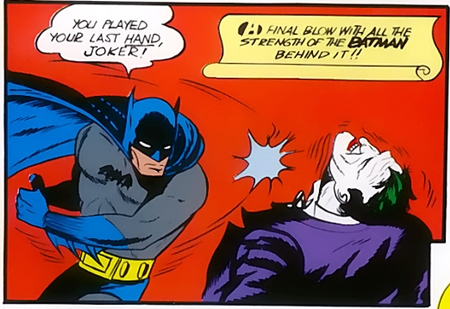
With the censorship and forced overly conservative stories throughout the 1950’s the Joker became more a criminal who played a lot of gags on Batman, and was not particularly threatening.

It was not until the 1970’s that the Joker got his teeth back, and returned to being the more sadistic gleeful killer and maniac he had been in his earliest pre-comics code appearances. When Neal Adams and Denny ‘O Neil worked together on Batman, they made a deliberate attempt to take Batman back to his Gothic roots.
Gone was the barrel-chested smiling cop Detective, and in his place was was the lithe gymnastic Batman, the first Batman who looked like he really knew martial arts, a globe trotting James Bond in a Batman costume. This 1970’s Batman incarnation was the beginning of the modern day Batman and paved the way for the Dark Knight we know and love today. As Batman grew darker and more Gothic once again, so the Joker returned to being more of a maniacal killer, and less an annoying clown.

From the 1970’s onward the Joker has gotten progressively darker, more psychotic, more… ‘evil’ for lack of a better word.
Frank Miller made the Joker an integral part of his Dark Knight Returns story. While the Joker’s role in Dark Knight Returns is small, it sets up the nature of the ongoing adversarial co-dependent relationship of Joker and Batman for the next several decades up to the present day.
To Miller’s Joker, Batman is his world, without him Joker’s life has no meaning. Without the “game” of playing with Batman, Miller’s Joker becomes a catatonic nobody, until Batman returns from retirement.
Meanwhile, Miller’s Batman (having moved on and retired from being Batman) has no real interest in the Joker, other than stopping him once again after they both come out of retirement. A brutal fight ensues where the Joker dies after repeatedly stabbing Batman is something of a sidebar in the larger story of Batman in The Dark Knight Returns. Yet that scene remains one of the most defining moments in the history of Batman’s encounters with the Joker. The Dark Knight and the Clown Prince coming alive again to face one another, two archetypes locked in an eternal symbolic struggle, the warring conflicted selves of man’s psyche.

Grant Morrison’t Joker is both villain and temporary friend when he assumes yet another identity during the R.I.P. and Return of Bruce Wayne / Batman Incorporated story arc.
Morrison plays up the trickster angle of Joker being both benevolent and potentially harmful. Menacing and deadly in one story arc, benevolent and seemingly a friend in another story arc. I won’t give any spoilers here even though the run finished a number of years ago. If you have not read Morrison’s run on Batman it is great fun, as is Scott Snyder’s NEW 52 Batman run.
Scott Snyder’s interpretation of the Joker has become the most depraved and disgusting version of the Joker yet. While there are elements of Snyder’s Joker that I just don’t agree with, he clearly set out with a particular unique vision of Batman and the Joker, and he accomplished what he set out to do in his five year run. It is no easy task to come up with a different take on a character who has been around for 70+ years and exists across a diverse range of media.

The other notable portrayals of the Joker in the modern era have been Paul Dini’s – both his incarnation in Batman Animated –voiced by Mark Hamill of Star Wars fame, and the Paul Dini penned Arkham Asylum game series by Rocksteady Studios.

In the Arkham Asylum video games and Batman Animated series Joker is a wild fun mix of his various elements and incarnations. More toned down violence in the Mark Hamill voiced cartoons, while more ramped up over the top and graphic violence in the video games. This is the same character, again, morphing and twisting to suit the audience (meaning the age ratings and what level of violence was permitted).
He’s the same clown putting on a show, no matter the venue. If you thought Deadpool was very “meta”, self-referential, funny and psychotic – then you really need to experience more of Mark Hamill / Paul Dini’s Joker tales, because the clown prince does murder, mayhem, psychosis and hilarity better than the Merc’ with a Mouth any day of the week.
In Batman Animated the Joker manages to be just as menacing and scary as any other incarnation -despite writers having to cater to network television rules for children’s entertainment – thanks to Star Wars’ Mark Hamill voicing the animated Joker in a fan favourite performance – on and off from 1992 to 2016. That’s 24 years. No other performer has even come close to playing the Joker for that length of time.

Mark Hamill gave us a version of the Joker who was over the top, the right mix of laughter and menace. To satisfy the requirements of a network TV show, the Batman Animated version of the Joker could not be overly violent or shown to be directly killing people in a show aimed at kids. But clever writing that satisfied the censors still managed to make him a menacing character, particularly in the direct market animated feature Batman Beyond: Revenge of the Joker – where Hamill’s Joker gets cut loose – he is every bit the gleeful sick sadistic psychopath made famous in the comic books.

In live action we have the big three icons – Cesar Romero, Jack Nicholson and Heath Ledger. Each bringing a unique vision of the Joker to life.
Cesar Romero’s Joker was a comical joking buffoon, a slapstick clown who jumped around everywhere and was very animated and over the top. Many fans found Frank Gorshin’s Riddler to be closer to the Joker from the comics. Cesar Romero’s Joker while clearly a unique take by a talented actor just has no menace at all. He’s more annoying than scary.
Compare him with his opposite in Heath Ledger’s Joker who is all menace with little to no humor. In the middle you have Jack Nicholson who is both deadly and funny. While Keaton’s Batman is a world away from the comic book Batman, Nicholson’s Joker is much closer to the comics, only one-upped by Mark Hamill who manages to be the most definitive Joker on screen in Batman Animated.

Jack Nicholson’s Joker was a great performance that veered between gleeful lunatic and unapologetic homicidal maniac. Burton’s Batman and Joker went back to Batman’s roots, emphasizing the Gothic elements of Batman like O’ Neil and Adams in the 70’s. Nicholson’s Joker was true to the earliest golden age appearances of the Joker. A career criminal who falls into a vat of acid and emerges as the Clown Prince of Crime.
Visually, Nicholson’s outfit is the closet to classical Joker we have seen on the big screen. In contrast Keaton’s Batman look is remarkable different from the comics being all black, rather than black/grey or black/blue. Keaton and Burton’s Batman look (the film and the costume) set the tone and style for all future theatrical incarnation’s of Batman, and even cosplayers today typically go with the all black costume when dressing up as their favourite Dark Knight Detective.

Heath Ledger’s Joker is a fan favourite performance, some would even say it was the performance of Ledger’s career. A more urban Joker whose hair is matted, whose face is a mess, but who still wears a nice suit with a dirty almost punk rock feel to it, Ledger’s Joker was all menace. A gleeful sadist who loves to torture Batman with indecision and doubt and keeping everybody guessing what his real plans and intentions were.
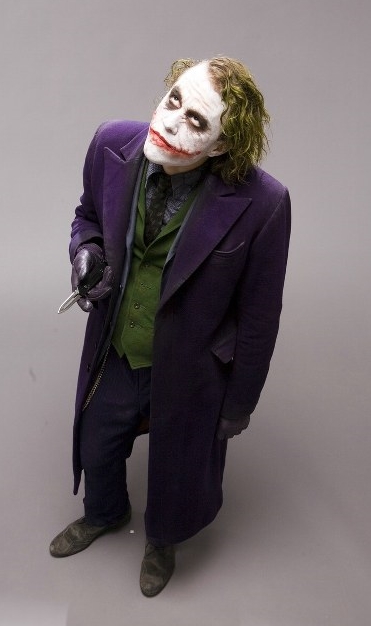
Another interesting take on the Joker was the Brian Azzarello / Lee Bermejo graphic novel “Joker”. This take sees the a hired goon tag along with the Joker for the day, and we see him get up to all his usual tricks. It’s a great read, and noteable for showing a more realist take on the Joker. Not so much his personality, but the overall setting and mood is closer to say Marvel’s the grim tone of The Ultimates or Watchmen than the usual Batman monthlies.

Origins of the Joker
The Red Hood first appeared in Detective Comics #168. In a rather convoluted page of exposition the Joker reveals to Batman the “one secret I’ve kept from you all these years”. That Joker was a lab worker who decided to steal $1,000,000 and became the Red Hood. He later swam through a chemicals making his getaway which bleached his skin and hair.

The Joker / Red Hood story is a bit silly, as were many Batman stories of its era. His origin would be told and retold over the decades, each time adding to or taking something away from the various stories he has told about who he is and why he exists. Fans still argue the true origin of the Joker to this day, and some theorists will state factually that his earliest origins are “most true”, but given 70+ years of fiction, and various writers – those details are up for debate and interpretation.
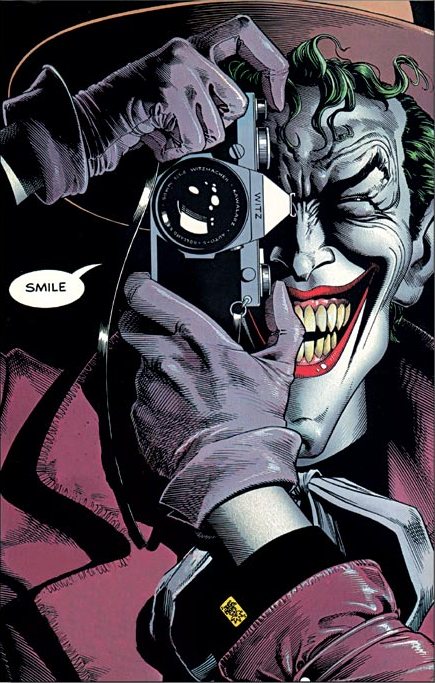
Allan Moore did his part to confuse things by writing The Killing Joke graphic novel. Moore wrote it as an out of continuity one-off story. One where he crippled Batgirl/Barbara Gordon. Then when DC published it, they went ahead and made it canon. Leaving poor Babs permanently crippled, something Moore has said he regrets adding to Batman. More ideas for Joker origins are thrown up in the air in The Killing Joke, which became a semi-canon. Until they were not any more. Well apart from Babs being crippled. They kept that part for some reasons and threw out pretty much everything else, until DC’s NEW 52 where both Joker and Babs get rebooted.

Joker as Mythic Archetype
In Snyder’s NEW 52 Batman story “End Game”, hints have been dropped that the Joker may be immortal. With images of the clown prince showing up old in photographs taken before Batman and the Joker were born.
The logical rational answer, the answer Batman has to go with is that the Joker is playing another cruel trick. The answer is that after taking a rare chemical called Dionesium (the precursor of Lazarus pits) the Joker is miraculously healed from life threatening injuries. The kicker is that photographic evidence exists putting the Joker at a least a century or two old. Older than Gotham itself. In Snyder’s end to his Joker stories (Death in the Family and End Game) the Joker gleefully torments Batman with the idea that he has been around a long, long time and is possibly immortal. Batman refuses to believe it of course, and the tale is left open ended for the reader to decide the ultimate truth of the Joker’s story, which again plays into the Archetype of the Trickster – a storyteller with multiple origins and many twisting lies and tricks.
In interviews with the site ComicBookResources.com Snyder and collaborator (artist) Greg Capullo talk about their vision for the Joker in the NEW 52.
CBR: What was your and Greg Capullo’s thinking behind that and how he appears now versus “Death Of The Family,” or even that very first “Batman” issue when Dick was pretending to be him in jail?
Snyder: The most important thing is that he looks scary, you know? The other most important thing, when we were talking about him, was that he looks reborn in some way. Classic, but a little bit darker. We talked about different possibilities. We talked about the purple suit, and then we realized, no matter how you cut it and what the suit is, it just makes him not scary in a lot of senses. So for us it became about giving him the black suit with the purple handkerchief, give him a more funeral look. Make the hair shorter on the sides, make sure his eyes are very wide, very bloodshot, the wider grin with the clownish chin and nose. Make him a little less witchy and a little more scary, someone who is in the shadows, looking at you, who is clearly a Joker, young and restarted. He’s come back saying, “This is it. If I’m moving on, I’m starting over without you.”

The cover to Batman #40 depicts and angelic Batman about to stab a Joker themed demonic creature with a staff / spear adorned with the Bat-symbol. It’s a great cover that emphasies the mythical archetypal relationship of the two adversarial characters in symbolic form.
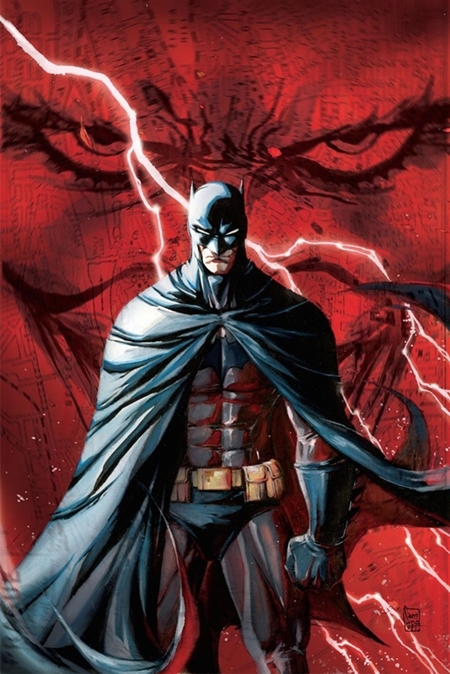
Snyder: And to me, the reason Batman is inspiring isn’t only because he terrifies criminals, but because he empowers us to go out and overcome our own fears, and to overcome the worry that what we do doesn’t mean anything, and that we can’t make a difference, we can’t change our situation. Batman is the ultimate example of how you overcome tragedy, or you take chaos and random violence and turn it into something meaningful.
Greg Capullo: Are you trying to say that they’re kind of like married, kind of like the yin and yang?
Snyder: Exactly. And I think Bruce knows that in some way. The Joker represents everything he fights against all the time.

Trickster characters are often inversions of popular beliefs and attitudes. Tricksters take whatever is repressed, hidden or unconscious and bring it out in the open for everyone to see.
The very act of bringing unconscious material to light makes the Trickster character if not unpopular at least confronting and unpleasant.
Not all trickster characters are malevolent, Bugs Bunny for examples is a lovable non-threatening character who plays tricks on his nemesis (Elmer Fudd, Daffy Duck), he is playful and challenges the ideas, values and perceptions of those he encounters.
Examples of classical mythological Trickster figures include half man-goat Pan, norse God Loki, and the African spider god/godess Anansi.
Modern Trickster figures include Bugs Bunny, Beetlejuice, The Joker and Dr. Who.
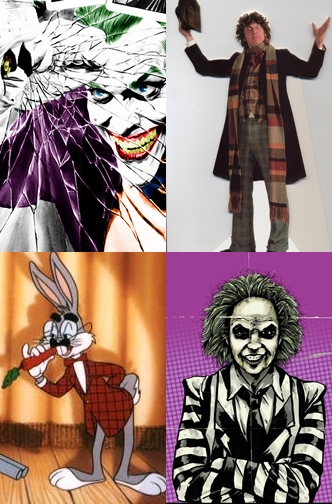
Joker as friend or benefactor to Batman
The trickster is not just a serial pest, but also acts in service to a higher purpose by bringing to light the very ideas and values we may find repulsive, and cannot stand to see in another, but which are in fact deeply embedded within our own psyches.
The more we are bothered by an other’s behavior, the greater the chance that there is some aspect of ourselves we are repressing, or refusing to own.
In this way, the trickster can symbolically help us to see our own Shadow qualities through story, song and performance.
Once these qualities or aspects of our own psyche are brought our attention, we still have to do the work of what Carl Jung refers to as “individuation” – being the war of opposites or dynamic tension between our higher and lower natures from which the “work” of real psychological growth and maturation into fully human beings comes.
The Joker at times has become a friend or benefactor to Batman (at least in his own warped view of reality). Joker sees himself as challenging Batman to be the best Batman he can be. He claims to know Batman better than anyone, as aspect that both Scott Snyder and Grant Morrison emphasized in their respective runs on Batman books.
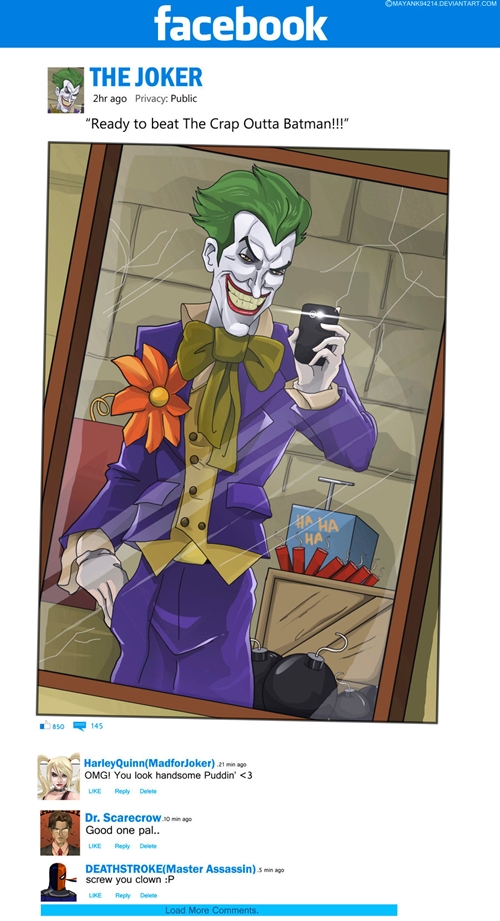
Joker as Madman and Cipher
The Joker as a foil to Batman reminds him of his own darker impulses, and is a constant reminder of walking next to the abyss but not falling into it. Of Batman not giving in to to his impulse to simply kill the criminals and lunatics rather than catch them.
In the mythical sense, the Joker can be viewed as an aspects of Batman’s own personality given personification. Where Batman does not kill, and rarely laughs or makes Jokes, and is all about discipline and control – the Joker is wild unrestrained Chaos. Pure hedonism, the embodiment of lower animal drives and desires which in themselves are not evil (fight or flight response, sex, death, survival etc) but which unrestrained make us no better than living in an animal state of consciousness.
However, animals generally kill for food or to protect themselves, whereas the Joker kills for the sheer fun of it, making him in a sense even less evolved than an animal. He is sub-human, a gross perversion of culture and humanity reflected back on itself.
The Joker is decadence and self-indulgence and greed and excess and wanton destruction of self and environment personified.
He is chaos and a man like Batman who looked into the abyss of his own soul and rather than finding the line between his higher and lower impulses, fell in love with chaos and and raw unimpeded impulsiveness.
Will the real Joker please stand up?
The Joker can be a blank slate, a blank canvas onto which a writer can project whatever they need to for the story they wish to tell. Joker is the dark side of humanity twisted beyond recognition, a gross reflection of the chaos and unpredictability of life itself. His meanings and symbolism change with the times, reflecting cultural patterns and ever shifting values. In more conservative times he is the silly annoying clown who is more of a pest than a true threat. In more progressive times Joker is the psychotic mass murdering lunatic, always pushing the boundaries of sanity and crime as an art form.
The Joker is the nameless nobody criminal, who reinvented himself as the costumed Red Hood, who reinvented himself becoming the Joker, the clown prince of crime, avatar of chaos and madness.
Whether the Joker is genuinely insane, or merely plays at being insane because he loves to hurt people and cause trouble is up for debate. There is no “correct” answer, both versions are valid, and each Batman writer creates their own version of the Joker, with evidence to support their views in the Batman canon.
Scott Snyder’s Joker seems to be a true psychopath who enjoys murder, mayhem and torture, and his recent End Game storyline is possibly building the Joker up as as some sort of immortal, devil or pure archetypal trickster character.
The deliberate invocation, or even the suggestion that the Joker may be more than some criminal lunatic who dresses like a clown makes for compulsive reading, and leave the reader with a sense of confusion at the end of the tale.
Similar ideas have been hinted at in stories such as Dark Knight Returns, that Joker and Batman give each other meaning, and that the Joker continues to push himself to new depravities just to fuck with Batman.
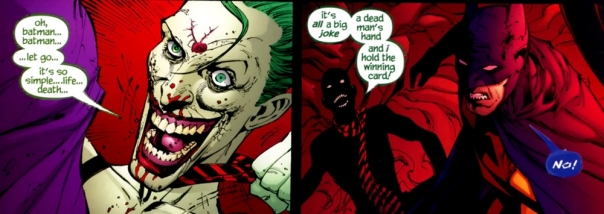
An End to Madness and Laughter?
The Joker’s characterisation varies by writer and era. Sometimes he is a loveable fun trickster, at other times career criminal. He plays at being a gang leader only to routinely kill his employees. Joker has been a lunatic, psychopath, sadist and clown. Or any combination of these qualities depending on what elements a given writer wants to emphasize.
The strength of the Joker, and the Trickster archetype is that he can be put into just about any kind of story, and he works. Like water that once poured into a glass becomes the glass, the Joker becomes whatever is needed in a given story. He is the clown prince of crime, career criminal, lunatic, shapeshifter, trickster and more. He is all of these things and yet not limited by any of these facets of his personality. He evolves and devolves, taking on new forms for new stories.
Each new interpretation of the Joker adds something to the collective archetype of “The Joker” in Batman media. Each writer or actor that comes along has their choice of which elements they want to use from all the interpretations so far, as well as adding something unique of themselves to the character.
One of the great things about the Joker is that if you don’t like a particular version – there is always a new interpretation right around the corner.
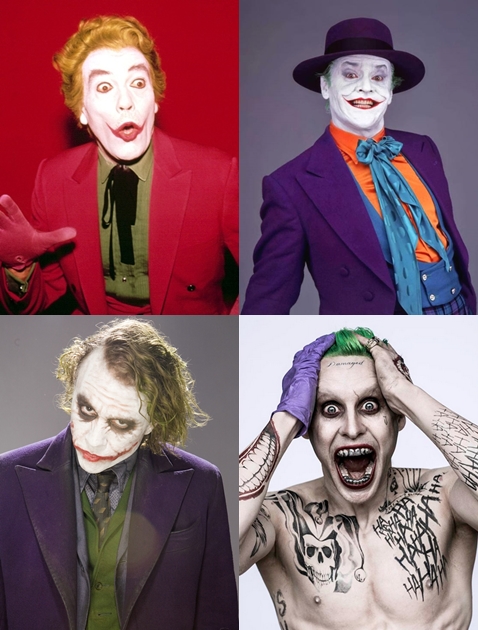
The Joker and Batman have a symbiotic relationship, as do most classic heroes and villains throughout literature and film, each hero and villain representing the aspects of human potential and personality through stories. Within each person are all archetypes and possibilities, the different aspects of our psyche being reflected symbolically in stories of exciting characters having adventures, facing challenges and becoming more than what they were, or simply entertaining us with a mindless distraction from our daily lives.
When we read a comic book the page is flat and two dimensional, but beyond the borders of the panels of simple ink on paper – our imagination soars as we expand those worlds to infinite dimensions. We see hear and feel the moments of simulated joy, sorrow and high drama our heroes and villains encounter. Those larger than life characters, however spectacular they may be ultimately remind us of how human we are.

“In mythology and religion, the trickster deity breaks the rules of the gods or nature, sometimes maliciously but usually, albeit unintentionally with ultimately positive effects. Often, the bending/breaking of rules takes the form of tricks or thievery, and their actions often end up changing the rules in the process of breaking them, much like an act of “civil disobedience”. Tricksters can be cunning or foolish or both; they are often funny even when considered sacred or performing important cultural tasks.” – TVtropes.org
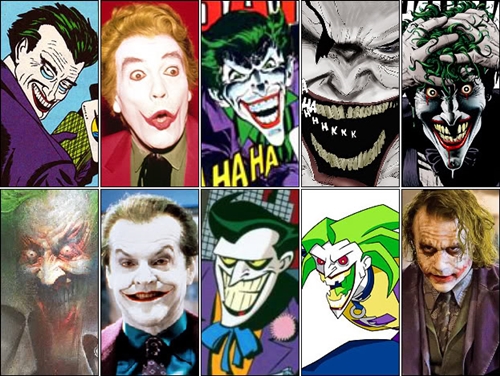
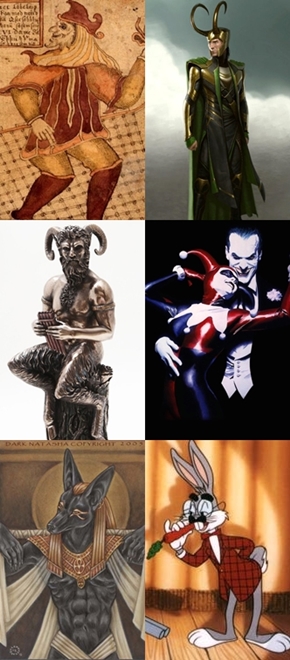
Outstanding work, Love it!
LikeLiked by 1 person
Thank you good Sir.
LikeLike
Wow that is SOME post!
LikeLiked by 1 person
Dude, this is a fantastic blog. I will keep reading only read this one and the previous one. I found you through Quora, where you nominated yourself, lol, but you are the best Batman Blog I have seen. Great job so far. Keep it up! I would love some feed back on my Batman blog as well.
LikeLiked by 1 person
Cool. Thanks. Added your blog to my feedly, looks good. Will give some feedback later when I get some free time.
LikeLike
Yeah I looked for other Batman blogs, and there are some, but they deal mainly with comic and movie news, if anyone can find anything similar to my essays online, then please link to them here in the comments as I am always looking for good Batman-content to read. Most of the good stuff is offline in print books. So much of it slips by most folks that I am going to do a big article highlighting all the great non-fiction books about Batman in an article later this year.
LikeLiked by 1 person
Reblogged this on Sef Ramos and commented:
Fantastic Article on the Joker
LikeLiked by 1 person
I’m doing research on the Trickster archetype right now and found this excellent piece. I didn’t know the rich history of Batman and the The Joker! I appreciate both the detail you’ve offered as well as the overview of Jung’s work to help with context.
I’ll be visiting your blog again. Thank you!
LikeLiked by 1 person
Yeah, I recommend Jung’s works, you can find some good stuff online if you google his name. I have loads of his books here for reference, and just read a bit now and then when I get time. Glad you enjoyed it! It was a fun article to write, and almost wrote itself that one, mostly Jung did the bulk of the work, LOL!
It also comes up in screen writing / TV and Film etc. check out TV TROPES http://tvtropes.org/pmwiki/pmwiki.php/Main/TheTrickster
LikeLiked by 1 person
Thank you! I’m currently reading Jung’s “The Archetypes and the Collective Unconscious” and, after reading the section titled “On the Psychology of the Trickster-Figure”, poked around on the internet and got to your blog.
I’ve been a student of Depth Psychology for many years and continue to be interested in how Psyche is bringing out these archetypes in pop culture through the comics. Your treatise here is some of the best I’ve seen in unpacking something that can be hard for people to grasp.
I look forward to more!
LikeLiked by 2 people
Thanks for the kind words. That volume of Jung’s works (vol 9 part 1 of collected works) is a great read. A good companion volume is “AION” aka Vol 9 part 2 https://www.amazon.com/Aion-Researches-Phenomenology-Collected-Works/dp/069101826X/ref=sr_1_2?ie=UTF8&qid=1485426175&sr=8-2&keywords=aion
and also “Man and his Symbols” by Jung and others which was one of his last ever works, and expressly written for the layman/non academic of his era etc to read, summing up many of his ideas. I highly recommend at least Jung’s chapter of “Man and his Symbols” which is in a cheap paperback, and I think the essay is likely online as well, but none of them are essential, so much as support and expand on the core work “Archetypes and Collective Unconscious” and of course Joseph Campbell’s work picks up where some of Jung’s stuff left off re Archetypes as they apply to fiction etc. Fun fact: Jung knew Campbell, Campbell knew Lucas and of course Lucas purposefully used Archetypes and the “Heroes Journey” for Star Wars so you can see the direct and indirect influence of both Jung and Campbell on Star Wars.
LikeLike
I also wrote two other articles that used Jungian theme and or symbols / framework etc if you are interested:
“I am Vengeance I am the Night” – Exploring the dark Psyche of Batman
The Darkness in Humanity – Batman as Avatar of our Shadow Self
LikeLike